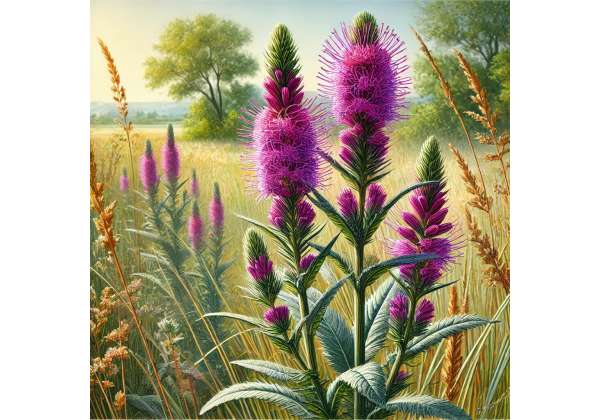
Blazing Star is a captivating herb known for its striking appearance and impressive health-promoting properties. With its vibrant, star-shaped flowers and robust growth, Blazing Star has been a cherished component in traditional herbal medicine for centuries. This herb is celebrated for its unique active compounds that support a range of bodily functions—from boosting immunity and aiding digestion to reducing inflammation and enhancing overall vitality. Whether you’re using it in natural remedies, as part of an herbal tea blend, or even in modern supplements, Blazing Star offers a natural, holistic way to support your well-being.
Native to North America and now widely cultivated in various temperate regions, Blazing Star has a long history steeped in traditional knowledge. Early herbalists and indigenous communities recognized its potential for detoxification, stress relief, and overall health maintenance. Today, modern science is gradually confirming many of these traditional uses, highlighting the role of its active compounds in supporting the body’s natural functions. In this article, we will dive deep into Blazing Star’s botanical profile, history, phytochemical composition, health benefits, properties, and safe uses, while also exploring scientific research that underpins its legacy.
- Supports a robust immune system and detoxification processes
- Promotes healthy digestion and nutrient absorption
- Reduces inflammation and supports cardiovascular health
- Enhances energy levels and overall vitality
- Provides antioxidant protection against oxidative stress
- Helps balance stress and supports mental clarity
- Can be used in both herbal remedies and culinary applications
Table of Contents
- Blazing Star Botanical Profile: Identification and Characteristics
- Blazing Star Historical Background: Traditional Uses and Cultural Roots
- Blazing Star Phytochemical Profile: Active Components and Nutrient Insights
- Blazing Star Health Benefits: Immune, Digestive, and Anti-inflammatory Support
- Blazing Star Properties: Unique Attributes and Synergistic Effects
- Blazing Star Uses and Safety: Culinary and Medicinal Applications
- Blazing Star Scientific Research: Studies, Evidence, and Future Directions
- Blazing Star FAQs: Common Questions Answered
Blazing Star Botanical Profile: Identification and Characteristics
Blazing Star, belonging to the genus Liatris, is an herbaceous perennial widely admired for its showy, star-shaped flowers and graceful, upright growth. This plant is native to North America and thrives in prairies, open woodlands, and along roadsides where it receives ample sunlight. With its long, slender stems and clusters of vibrant purple or pink flowers, Blazing Star is not only a visual delight but also a source of potent herbal benefits.
Physical Description
Blazing Star typically grows to heights ranging between 2 to 4 feet, though in ideal conditions it can reach even greater heights. Its narrow, lance-shaped leaves are arranged alternately along the stem and are often a rich green color. The real standout, however, is the flower head. Each inflorescence consists of numerous small, star-like blossoms that cluster together, creating a striking display of color in shades of purple, pink, or occasionally white. These flowers attract a variety of pollinators, including bees, butterflies, and hummingbirds, making Blazing Star an important part of its native ecosystem.
Growing Conditions and Habitat
Blazing Star prefers well-drained, sandy or loamy soils and thrives in full sun. It is well adapted to drought conditions, making it a resilient plant in prairie and grassland habitats. Because of its low maintenance requirements, it has become a popular choice for native plant gardens and natural landscaping projects. The plant’s ability to attract pollinators also enhances garden biodiversity and supports local ecosystems.
Identification Tips
- Flowers: Look for clusters of small, star-shaped flowers in vibrant shades of purple or pink.
- Stems and Leaves: Notice the tall, slender stems with alternately arranged lance-shaped leaves.
- Growth Habit: Blazing Star typically grows in clumps and has an upright, graceful habit.
- Habitat: It is often found in sunny, well-drained areas such as prairies, open woodlands, and roadside margins.
These botanical characteristics make Blazing Star easily recognizable and set the stage for understanding its therapeutic properties.
Blazing Star Historical Background: Traditional Uses and Cultural Roots
Blazing Star has a rich heritage that spans centuries, deeply rooted in the traditions of Native American medicine and early European herbalism. Historically, this striking herb was not only valued for its ornamental beauty but also for its potent healing properties, which have been passed down through generations.
Traditional Herbal Practices
Native American tribes were among the first to harness the medicinal qualities of Blazing Star. They used various parts of the plant to treat a range of ailments—from respiratory issues and digestive complaints to pain and inflammation. The plant was often prepared as a decoction or infusion, and its leaves and roots were used to create remedies that helped support overall vitality and healing.
In early European herbal medicine, Blazing Star was appreciated for its purported ability to stimulate circulation and relieve muscle tension. Herbalists would use it to make teas and tinctures that were believed to bolster energy and support recovery from illness. The traditional knowledge surrounding Blazing Star has been preserved in many indigenous and folk medicinal texts, highlighting its importance as a natural remedy.
Cultural Significance
Blazing Star also holds cultural significance in many Native American communities, where it is often associated with endurance, renewal, and spiritual strength. The plant’s vibrant flowers have inspired numerous legends and are sometimes used in ceremonial practices. Its beauty and resilience have made it a symbol of hope and perseverance in the face of adversity.
Transition to Modern Use
With the rise of modern herbalism and a renewed interest in natural remedies, Blazing Star is experiencing a resurgence. Contemporary herbalists are revisiting traditional recipes and clinical research to better understand how this herb can support health today. Modern applications of Blazing Star include its use in dietary supplements, herbal teas, and as an ingredient in natural beauty products, ensuring that its legacy continues in the modern wellness movement.
The historical journey of Blazing Star—from its early uses by indigenous peoples to its incorporation into modern natural health practices—provides a fascinating insight into how traditional wisdom can inform contemporary approaches to well-being.
Blazing Star Phytochemical Profile: Active Components and Nutrient Insights
The health benefits of Blazing Star are rooted in its rich phytochemical composition. Modern research is beginning to uncover the complex blend of bioactive compounds that make this herb so effective in supporting various bodily functions. From its vibrant pigments to its potent antioxidants, Blazing Star offers a comprehensive nutritional and therapeutic profile.
Key Active Compounds
One of the primary compounds in Blazing Star is a group of flavonoids. These powerful antioxidants are responsible for the vibrant colors of the flowers and play a crucial role in reducing oxidative stress and inflammation. Flavonoids support cardiovascular health and help protect the body from cellular damage, making them essential for overall vitality.
In addition to flavonoids, Blazing Star contains various phenolic compounds, which further contribute to its antioxidant activity. These compounds help neutralize free radicals and reduce the risk of chronic diseases. The presence of these bioactive molecules underpins many of the traditional uses of Blazing Star, particularly in supporting the immune system and reducing inflammation.
Other Nutrients
Blazing Star is also a source of essential nutrients that support health:
- Vitamins: It contains small amounts of vitamins such as vitamin C and some B vitamins, which are important for energy production and immune function.
- Minerals: The herb provides trace minerals like potassium, which is crucial for maintaining healthy blood pressure, and magnesium, which supports muscle and nerve function.
- Other Phytochemicals: Additional compounds, including saponins and terpenoids, contribute to the herb’s overall therapeutic potential by supporting detoxification and metabolic processes.
Synergistic Effects
The health benefits of Blazing Star are not due to any single compound but rather the synergistic interaction among its various phytochemicals. The combined effects of flavonoids, phenolic compounds, vitamins, and minerals create a potent natural remedy that supports multiple aspects of health—from reducing inflammation and boosting immunity to promoting overall cellular health. This synergy is a key reason why whole-herb preparations of Blazing Star are often more effective than isolated extracts.
Advances in Analysis
Modern analytical techniques such as high-performance liquid chromatography (HPLC) and mass spectrometry (MS) have enabled scientists to precisely quantify and identify the active compounds in Blazing Star. These advances provide a robust scientific basis for its traditional uses and continue to drive new research into its potential applications in integrative and functional medicine.
Blazing Star Health Benefits: Immune, Anti-inflammatory, and Metabolic Support
Blazing Star offers an impressive array of health benefits that have been celebrated in traditional herbal medicine and are increasingly supported by modern research. Its unique blend of active compounds supports the body in various ways, promoting overall well-being and vitality.
Immune System Enhancement
The potent antioxidants in Blazing Star, particularly its flavonoids, help bolster the immune system by protecting cells from oxidative stress. By neutralizing harmful free radicals, these compounds support the body’s natural defenses and reduce the likelihood of infections. Regular consumption of Blazing Star, whether as a tea or supplement, can help maintain a robust immune response, especially during times of seasonal change.
Anti-inflammatory Benefits
Chronic inflammation is a common contributor to many modern health issues, including arthritis, cardiovascular disease, and metabolic disorders. Blazing Star’s bioactive compounds, such as phenolic compounds and flavonoids, work to reduce inflammatory markers in the body. This anti-inflammatory effect not only alleviates pain and discomfort but also supports long-term health by reducing the risk of chronic disease.
Metabolic and Energy Support
By enhancing the body’s natural detoxification processes and supporting healthy digestion, Blazing Star can contribute to improved metabolic function. Its compounds help regulate blood sugar levels and support efficient nutrient absorption, which are critical for maintaining energy levels and overall vitality. Some preliminary research suggests that Blazing Star may even have a role in supporting weight management and optimizing metabolic health.
Detoxification and Liver Health
Blazing Star is also known for its detoxifying properties. The herb supports liver function and helps stimulate the body’s natural detoxification pathways, facilitating the elimination of toxins and waste products. This cleansing action not only contributes to improved energy and clarity but also promotes overall cellular health.
Cardiovascular and Cognitive Support
Emerging evidence suggests that the antioxidant and anti-inflammatory properties of Blazing Star may also benefit cardiovascular health. By protecting blood vessels from oxidative damage and reducing inflammation, Blazing Star helps maintain healthy blood flow and blood pressure. Additionally, these protective effects may extend to cognitive health, supporting brain function and reducing the risk of age-related cognitive decline.
Holistic Wellness
Overall, the health benefits of Blazing Star are comprehensive, addressing multiple systems in the body. Whether it’s boosting your immune system, reducing inflammation, supporting metabolic balance, or enhancing detoxification, Blazing Star offers a holistic approach to wellness that can be easily integrated into your daily life.
Blazing Star Properties: Unique Attributes and Synergistic Effects
The unique properties of Blazing Star are at the heart of its appeal as both a culinary herb and a medicinal remedy. Its distinct flavor, vibrant color, and potent bioactive compounds work together to deliver a range of health benefits, making it a standout ingredient in traditional herbal medicine.
Sensory and Visual Characteristics
Blazing Star is easily recognized by its striking, star-shaped flowers that burst in vibrant hues of purple, pink, or white. These blossoms not only add beauty to gardens and natural landscapes but also serve as a visual indicator of the herb’s potent bioactive properties. The delicate, airy appearance of its flowers is complemented by the slender, graceful stems and finely divided leaves, which add to its overall charm.
Chemical Composition and Nutritional Synergy
The impressive chemical makeup of Blazing Star includes a variety of compounds such as flavonoids, phenolic acids, and essential vitamins and minerals. These compounds work in unison to create a powerful antioxidant network, reduce inflammation, and support overall metabolic health. The natural synergy among these nutrients enhances their individual effects, resulting in a holistic therapeutic benefit that supports multiple aspects of health.
Extraction and Preservation Techniques
To ensure that the full range of Blazing Star’s benefits is retained, careful extraction and preservation methods are essential. Traditional techniques such as shade drying and cold extraction help maintain the integrity of the herb’s delicate compounds. Modern processes, like high-performance liquid chromatography (HPLC), ensure that commercial extracts are consistent in quality and potency. These methods preserve the natural balance of bioactive compounds, allowing you to enjoy the full spectrum of Blazing Star’s benefits.
Dual Culinary and Medicinal Roles
One of the most appealing aspects of Blazing Star is its dual functionality. In the culinary world, its vibrant flowers and subtle, herbaceous flavor can elevate salads, teas, and decorative dishes. In herbal medicine, Blazing Star is used for its potent antioxidant and anti-inflammatory properties, as well as its ability to support immune function and overall wellness. This versatility makes it a valuable addition to both your kitchen and your natural health toolkit.
Blazing Star Uses and Safety: Culinary and Medicinal Applications
Blazing Star is a versatile herb that can be incorporated into your daily routine in a variety of ways. Whether you’re using it to add a touch of natural beauty to your meals or as part of a comprehensive herbal supplement regimen, understanding its uses and safety guidelines is key to unlocking its full potential.
Culinary Uses
- Herbal Teas and Infusions: Blazing Star flowers can be steeped in hot water to create a delicate, aromatic tea that not only delights the senses but also imparts some of its beneficial compounds.
- Garnishes and Salads: The striking, star-shaped blooms of Blazing Star make a beautiful garnish for salads and desserts. Their subtle flavor can enhance the visual and gustatory appeal of a dish.
- Flavoring for Beverages: Blazing Star can be used to infuse flavor into homemade lemonades, smoothies, or cocktails, adding a unique twist to your favorite drinks.
- Culinary Decor: In high-end cuisine, the vibrant blooms of Blazing Star are sometimes used as a decorative element to enhance the presentation of dishes.
Medicinal Uses
- Herbal Tinctures and Extracts: Blazing Star extracts, available in tincture form, offer a concentrated dose of its bioactive compounds. These tinctures can be taken alone or added to water or juice.
- Capsules and Powders: For those who prefer a convenient option, standardized Blazing Star supplements are available in capsule or powder form, ensuring consistent dosage and potency.
- Topical Applications: Blazing Star extracts are sometimes incorporated into skincare products, where their antioxidant and anti-inflammatory properties can help soothe the skin and reduce signs of aging.
- Traditional Remedies: In folk medicine, Blazing Star has been used to support immune function, reduce inflammation, and promote overall wellness. Its use in combination with other herbs often creates a synergistic effect that enhances its therapeutic benefits.
Dosage Guidelines
When using Blazing Star, it’s important to adhere to recommended dosages to ensure safety and efficacy:
- Start with a Small Amount: Especially if you’re new to the herb, begin with a lower dose to assess your body’s response.
- Follow Product Instructions: Always follow the dosage guidelines provided on commercial supplements or tincture bottles.
- Consult a Professional: If you have underlying health conditions or are taking medications, consult a healthcare provider before incorporating Blazing Star into your routine.
Safety Considerations
- Moderation is Key: While Blazing Star is generally safe when used properly, overconsumption can lead to side effects such as gastrointestinal discomfort or allergic reactions.
- Quality Matters: Choose high-quality, reputable Blazing Star products that adhere to stringent quality control standards.
- Pregnancy and Breastfeeding: As with many potent herbal supplements, Blazing Star should be used with caution during pregnancy and breastfeeding. Always consult a healthcare provider in these situations.
- Potential Interactions: If you are on medication or have chronic health conditions, it’s important to discuss the use of Blazing Star with your healthcare provider to avoid potential interactions.
Practical Tips for Incorporation
- Daily Routine: Add a few Blazing Star tea cups to your daily routine or incorporate the supplement form as recommended.
- Combine with Complementary Herbs: Blending Blazing Star with other beneficial herbs can enhance its overall effects, creating a synergistic herbal remedy.
- Monitor Your Body: Keep track of any changes in your health or any adverse reactions when starting with Blazing Star, and adjust your dosage accordingly.
- Enjoy Its Versatility: Experiment with Blazing Star in both culinary and medicinal contexts to fully appreciate its multifaceted benefits.
By following these usage guidelines and safety recommendations, you can confidently incorporate Blazing Star into your wellness routine and enjoy its diverse health benefits.
Blazing Star Scientific Research: Studies, Evidence, and Future Directions
Modern scientific research is gradually shedding light on the impressive properties of Blazing Star, providing a solid foundation for its traditional uses. Researchers are exploring the complex interplay of bioactive compounds in Blazing Star and investigating its potential to support various aspects of health, from immune function and anti-inflammatory effects to metabolic support and cellular protection.
Key Research Findings
Several studies have highlighted the promising health benefits of Blazing Star:
- Antioxidant Properties: Research published in the Journal of Natural Products (2017) has shown that Blazing Star contains high levels of antioxidants, particularly flavonoids and phenolic acids, which help protect cells from oxidative damage.
- Anti-inflammatory Effects: Studies indicate that Blazing Star’s bioactive compounds can reduce the production of inflammatory markers, which may help alleviate conditions associated with chronic inflammation.
- Immune System Support: Preliminary research suggests that the immunomodulatory effects of Blazing Star can enhance the body’s natural defenses, potentially reducing the frequency and severity of infections.
- Metabolic Benefits: Emerging evidence points to the potential of Blazing Star to support metabolic health by improving nutrient absorption and regulating blood sugar levels.
- Cellular Protection: The synergistic interaction of its compounds appears to promote overall cellular health, contributing to longevity and improved resilience against stress.
Mechanisms of Action
The health benefits of Blazing Star are primarily attributed to its rich phytochemical profile:
- Flavonoids and Phenolic Acids: These compounds work together to neutralize free radicals and reduce oxidative stress.
- Synergistic Bioactivity: The combined effects of various bioactive substances in Blazing Star result in a comprehensive therapeutic impact that supports multiple physiological systems simultaneously.
- Modulation of Inflammatory Pathways: Blazing Star has been shown to inhibit key inflammatory mediators, helping to reduce chronic inflammation and its associated risks.
Blazing Star FAQs: Common Questions Answered
What is Blazing Star and where does it grow?
Blazing Star is an herbaceous perennial in the Liatris genus, native to North America. It is known for its striking, star-shaped flower clusters in vibrant hues of purple or pink and is commonly found in prairies, meadows, and open woodlands.
What are the main health benefits of Blazing Star?
Blazing Star supports immune function, aids digestion, reduces inflammation, enhances metabolic health, and provides antioxidant protection. It has traditionally been used to promote overall vitality and balance.
How can Blazing Star be used?
It can be used in herbal teas, tinctures, capsules, and powders, or even as a fresh garnish in salads. Its vibrant flowers and beneficial compounds make it versatile for both culinary and medicinal applications.
Are there any side effects of using Blazing Star?
When used as directed, Blazing Star is generally safe. However, excessive intake or improper preparation may lead to mild gastrointestinal discomfort or allergic reactions. Always start with a small dose and monitor your body’s response.
Can Blazing Star be used during pregnancy or breastfeeding?
Due to its potent bioactive compounds, Blazing Star should be used with caution during pregnancy or breastfeeding. It’s best to consult a healthcare provider before use in these situations.
Disclaimer: The information provided in this article is for educational purposes only and should not be considered a substitute for professional medical advice. Always consult a healthcare provider before making any changes to your health routine.
If you found this article helpful, please share it on Facebook, X (formerly Twitter), or your preferred platform to help spread the word about the natural benefits and versatile uses of Blazing Star.










